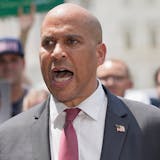A relaxation of COVID-19 restrictions is expected to be announced Thursday along with a 70% vaccination target that could trigger significant reductions in remaining mitigation strategies in Minnesota.
Gov. Tim Walz declined to give specifics at a public appearance Tuesday, but in previous events he has said the next incremental changes would likely involve expanded capacity limits for businesses and entertainment venues. He predicted a "very normal looking summer" if Minnesota can proceed from a rate of 59% of eligible people who have received some vaccine to 70%, perhaps in June.
"Minnesotans have done what was asked," Walz said. "We out-vaccinated that surge where hospitals were getting overwhelmed in states like Michigan and now in Oregon. It didn't happen in Minnesota because we're still doing the mitigation efforts and we're still vaccinating. ... The projections look incredibly good."
Minnesota's daily pandemic report on Tuesday was the first since March 23 to report fewer than 1,000 newly diagnosed infections with the SARS-CoV-2 coronavirus that causes COVID-19, and the first since March 26 to show a positivity rate of COVID-19 diagnostic testing below 6%. Mayo Clinic's 14-day COVID-19 forecast also predicted a 22% decline in daily SARS-CoV-2 infections in Minnesota by May 16.
The state also reported that nearly 2.6 million people 16 and older have received at least first doses of vaccine — 59% of the total eligible population — and nearly 2 million of them have completed the one- or two-dose series. Walz said Minnesota is progressing at a rate of a percentage point every three days, but some indications suggest the state won't be able to maintain that pace.
The number of weekly doses administered — including first and second doses — has fallen in Minnesota from 405,870 in the seven-day period starting April 4 to 276,234 in the seven-day period starting April 25.
State infectious disease director Kris Ehresmann said progress was easier when motivated people waited in lines and scanned computers for appointments, but that it will take sophisticated outreach to get to remaining people who are either hesitant or have work or transportation obstacles.
"Successes are going to be harder to come by in this phase," she said. "So we need to celebrate all of them. Anytime we move up by a percentage point of Minnesotans who are vaccinated, that's a big deal, because the work that is necessary to reach people is going to be a bit harder."



